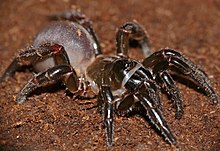| Domiothelina | |
|---|---|

| |
| Cteniza sauvagesi | |
| Scientific classification | |
| Domain: | Eukaryota |
| Kingdom: | Animalia |
| Phylum: | Arthropoda |
| Subphylum: | Chelicerata |
| Class: | Arachnida |
| Order: | Araneae |
| Infraorder: | Mygalomorphae |
| Clade: | Bipectina |
| Clade: | Domiothelina Raven, 1985 (as a "megapicoorder") |
| Families | |
Domiothelina is a clade of avicularioid mygalomorph spiders first proposed by Robert J. Raven in 1985, based on a morphological cladistic analysis. Raven characterized the clade by a number of shared features, including the domed apical segment of the posterior lateral spinnerets. The clade has been supported to some degree by subsequent molecular analyses, although with a somewhat different composition.
Taxonomy
The clade Domiothelina was first proposed by Robert J. Raven in 1985, based on a purely morphological cladistic analysis. Raven characterized the clade by a number of shared features, including the domed apical segment of the posterior lateral spinnerets (hence the name of the clade), a preliminary stage in the reduction of teeth on the claws, and the presence of an outer row of teeth on the cheliceral margin. The clade was supported by some subsequent analyses, including those that included molecular evidence, although with somewhat different family compositions. Spinneret morphology has been shown not to be useful for higher level classification in mygalomorph spiders, which now relies largely on molecular evidence.
Phylogeny
The preferred cladogram from a 2020 phylogenetic study of the Mygalomorphae is shown below. Domiothelina was resolved as one of the clades basal to the largest clade in the Bipectina, Crassitarsae. Some nodes within Bipectina had lower support (marked ♦ below), but Domiothelina was well supported.
| Avicularioidea |
| ||||||||||||||||||||||||||||||||||||||||||||||||||||||||||||
Domiothelina is estimated to have diverged from its sister clade around 161–145 Ma (the end of the Jurassic). The ancestor of the Avicularioidea probably used a sheet web to aid in prey capture. Most extant members of the Bipectina clade, including Domiothelina, have instead a burrow with one or more trapdoors and radial alarm threads. Trapdoors have been shown to reduce foraging efficiency, but may serve as protection from predators or adverse environmental factors. Reduced selection pressure may explain why the euctenizid genus Apomastus has lost trapdoors and has an open burrow.
Families
According to Opatova et al. (2020), the clade includes the following families (as circumscribed by them):
References
- ^ Raven, Robert J. (1985), "The spider infraorder Mygalomorphae (Araneae) : cladistics and systematics", Bulletin of the AMNH, 182, hdl:2246/955, retrieved 2016-01-18
- ^ Hedin, Marshal & Bond, Jason E. (2006), "Molecular phylogenetics of the spider infraorder Mygalomorphae using nuclear rRNA genes (18S and 28S): Conflict and agreement with the current system of classification", Molecular Phylogenetics and Evolution, 41 (2): 454–471, doi:10.1016/j.ympev.2006.05.017, PMID 16815045
- ^ Bond, Jason E.; Hendrixson, Brent E.; Hamilton, Chris A. & Hedin, Marshal (2012), "A Reconsideration of the Classification of the Spider Infraorder Mygalomorphae (Arachnida: Araneae) Based on Three Nuclear Genes and Morphology", PLOS ONE, 7 (6): e38753, doi:10.1371/journal.pone.0038753, PMC 3378619, PMID 22723885
- ^ Opatova, Vera; Hamilton, Chris A.; Hedin, Marshal; Montes De Oca, Lauren; Král, Jiři; Bond, Jason E. (2019), "Phylogenetic Systematics and Evolution of the Spider Infraorder Mygalomorphae Using Genomic Scale Data", Systematic Biology, 69 (4): 671–707, doi:10.1093/sysbio/syz064, PMID 31841157
- Bond, Jason E.; Garrison, Nicole L.; Hamilton, Chris A.; Godwin, Rebecca L.; Hedin, Marshal & Agnarsson, Ingi (2014), "Phylogenomics Resolves a Spider Backbone Phylogeny and Rejects a Prevailing Paradigm for Orb Web Evolution", Current Biology, 24 (15): 1765–1771, doi:10.1016/j.cub.2014.06.034, PMID 25042592